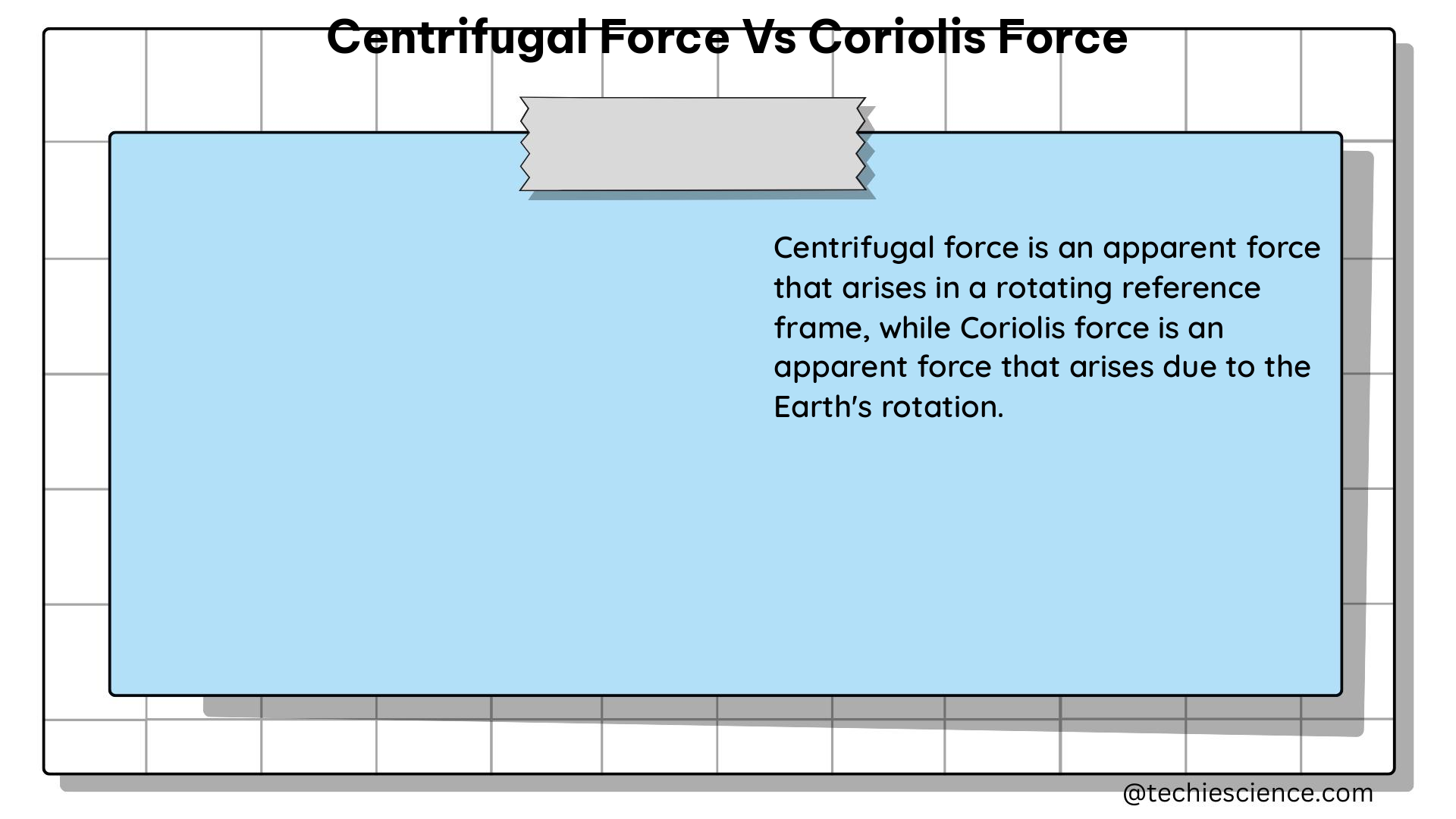Centrifugal force and Coriolis force are two distinct yet interrelated concepts in the realm of physics, particularly in the study of rotating reference frames. These fictitious forces play a crucial role in understanding the behavior of objects and systems in various applications, from satellite orbits to weather patterns. In this comprehensive guide, we will delve into the technical details, mathematical expressions, and practical examples of these forces, providing a valuable resource for science students.
Understanding Centrifugal Force
Centrifugal force is a fictitious force that arises in a rotating reference frame, acting outward from the axis of rotation. The mathematical expression for centrifugal force is given by the equation:
F_c = m * ω^2 * r
Where:
– F_c is the centrifugal force
– m is the mass of the object
– ω is the angular velocity of the rotating frame
– r is the distance from the axis of rotation
The centrifugal force is responsible for the sensation of being “pushed” outward when rotating in a circle, as it acts perpendicular to the axis of rotation. This force plays a crucial role in maintaining the stability of satellite orbits, where it balances the gravitational force pulling the satellite towards the Earth, resulting in a stable circular or elliptical orbit.
Centrifugal Force Examples
-
Satellite Orbits: As mentioned earlier, the centrifugal force acting on a satellite in orbit around the Earth balances the gravitational force, allowing the satellite to maintain a stable orbit.
-
Amusement Park Rides: Centrifugal force is responsible for the sensation of being “pushed” outward on rides like the Ferris wheel or the loop-the-loop roller coaster.
-
Washing Machines: The spinning motion of a washing machine drum creates a centrifugal force that helps to extract water from the clothes during the spin cycle.
-
Centrifuges: Centrifugal force is utilized in centrifuges, which are used to separate substances of different densities, such as in the purification of blood samples or the production of certain chemicals.
Understanding Coriolis Force

Coriolis force is another fictitious force that arises in a rotating reference frame, acting perpendicular to both the velocity of the object and the axis of rotation. The mathematical expression for Coriolis force is given by the equation:
F_c = -2 * m * v * ω * sin(θ)
Where:
– F_c is the Coriolis force
– m is the mass of the object
– v is the velocity of the object in the rotating frame
– ω is the angular velocity of the rotating frame
– θ is the angle between the velocity vector and the axis of rotation
The Coriolis force is responsible for the apparent deflection of moving objects in rotating systems, such as the path of a storm system in the atmosphere or the trajectory of a ball rolling on a rotating platform. In the Northern Hemisphere, the Coriolis force causes large-scale weather systems to rotate counterclockwise, while in the Southern Hemisphere, they rotate clockwise.
Coriolis Force Examples
-
Weather Patterns: The Coriolis force plays a significant role in the formation and movement of large-scale weather systems, such as hurricanes and cyclones, causing them to rotate in a specific direction.
-
Ballistic Trajectories: The Coriolis force can affect the trajectory of projectiles, such as artillery shells or long-range missiles, causing them to deviate from their expected path.
-
Foucault Pendulum: The Coriolis force can be observed in the motion of a Foucault pendulum, which demonstrates the rotation of the Earth by the apparent change in the plane of oscillation of the pendulum.
-
Ocean Currents: The Coriolis force influences the direction of ocean currents, contributing to the formation of large-scale circulation patterns, such as the Gulf Stream and the Kuroshio Current.
Comparing Centrifugal and Coriolis Forces
While both centrifugal and Coriolis forces are fictitious forces that arise in rotating reference frames, they have distinct mathematical expressions and effects on moving objects.
| Characteristic | Centrifugal Force | Coriolis Force |
|---|---|---|
| Mathematical Expression | F_c = m * ω^2 * r |
F_c = -2 * m * v * ω * sin(θ) |
| Direction | Acts outward, perpendicular to the axis of rotation | Acts perpendicular to both the velocity of the object and the axis of rotation |
| Effect | Causes objects to move outward from the axis of rotation | Causes objects to deflect in a direction perpendicular to their velocity and the axis of rotation |
| Examples | Satellite orbits, amusement park rides, washing machines | Weather patterns, ballistic trajectories, Foucault pendulum, ocean currents |
Experimental Demonstration
To better understand the differences between centrifugal and Coriolis forces, you can perform a simple DIY experiment using a turntable or a lazy Susan:
- Obtain a turntable or lazy Susan and mount it on a stable surface.
- Place a small object, such as a ball, on the turntable.
- Start the turntable rotating at a constant angular velocity.
- Observe the motion of the ball as it moves around the turntable.
- Introduce a small perturbation to the ball’s motion, such as gently pushing it.
- Observe the path of the ball as it responds to the perturbation.
By analyzing the motion of the ball, you can identify the effects of both centrifugal and Coriolis forces. The centrifugal force will cause the ball to move outward, away from the axis of rotation, while the Coriolis force will cause the ball to deflect in a direction perpendicular to its velocity and the axis of rotation.
Measuring Centrifugal and Coriolis Forces
The magnitude and direction of centrifugal and Coriolis forces can be measured using various instruments and techniques, including:
-
Accelerometers: Accelerometers can be used to measure the acceleration experienced by an object in a rotating reference frame, which can be used to calculate the centrifugal and Coriolis forces acting on the object.
-
Gyroscopes: Gyroscopes can be used to measure the angular velocity of a rotating reference frame, which is a key parameter in the calculation of both centrifugal and Coriolis forces.
-
Laser Interferometers: Laser interferometers can be used to precisely measure the displacement of an object in a rotating reference frame, which can be used to calculate the centrifugal and Coriolis forces acting on the object.
-
Numerical Simulations: Computational fluid dynamics (CFD) simulations can be used to model the behavior of objects in rotating reference frames, allowing for the calculation and visualization of centrifugal and Coriolis forces.
By using these measurement techniques, scientists and engineers can quantify the effects of centrifugal and Coriolis forces in a wide range of applications, from satellite design to weather forecasting.
Conclusion
Centrifugal force and Coriolis force are two fundamental concepts in the study of rotating reference frames, with distinct mathematical expressions and effects on moving objects. Understanding these forces is crucial for a wide range of scientific and engineering applications, from satellite orbits to weather patterns. By exploring the technical details, examples, and experimental demonstrations presented in this guide, science students can develop a deeper understanding of these important physical phenomena.
References
- Intuition and Difference Between Centrifugal Force & Coriolis Force
- Simple quantitative examples illustrating how the centrifugal and Coriolis forces ‘rescue’ Newton’s second law in rotating frames
- Centrifugal and Coriolis forces in rotating frames

I have a background in Aerospace Engineering, currently working towards the application of Robotics in the Defense and the Space Science Industry. I am a continuous learner and my passion for creative arts keeps me inclined towards designing novel engineering concepts.
With robots substituting almost all human actions in the future, I like to bring to my readers the foundational aspects of the subject in an easy yet informative manner. I also like to keep updated with the advancements in the aerospace industry simultaneously.